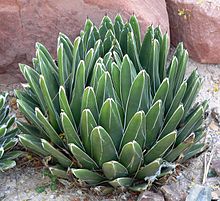bio.wikisort.org - Plant
Agave victoriae-reginae, the Queen Victoria agave or royal agave, is a small species of succulent flowering perennial plant, noted for its streaks of white on sculptured geometrical leaves, and popular as an ornamental.
| Queen Victoria's agave | |
|---|---|
 | |
Conservation status | |
| Scientific classification | |
| Kingdom: | Plantae |
| Clade: | Tracheophytes |
| Clade: | Angiosperms |
| Clade: | Monocots |
| Order: | Asparagales |
| Family: | Asparagaceae |
| Subfamily: | Agavoideae |
| Genus: | Agave |
| Species: | A. victoriae-reginae |
| Binomial name | |
| Agave victoriae-reginae T. Moore (1875) | |
| Synonyms[2][3] | |
| |
This agave is highly variable in form, but in general the rosettes are small and compact, growing to 0.5m, composed of short, rigid, thick leaves that are green with a pattern of distinctive white markings. The markings are generally along leaf keels or margins, giving a sort of polyhedral appearance. Marginal teeth are usually lacking, while the terminus of the leaf may include 1 to 3 spines, each 1.5–3 cm in length. Cream coloured flowers are borne in erect racemes up to 4m in length.
A. victoriae-reginae is found in the Chihuahuan Desert in the Mexican States of Coahuila, Durango and Nuevo León, with about a half-dozen subspecies named. The situation is complicated by hybrids with a number of other agave species.[4][5] Although it faces some local threats, the population of the species as a whole is stable, and it is not considered by the IUCN to be threatened.[1]
It is cold-hardy as agaves go, and thus finds favor as a small accent in many northerly gardens. However it is recommended in the UK that this plant be kept in heated conditions under glass during winter. It has gained the Royal Horticultural Society's Award of Garden Merit.[6] When grown as a houseplant, it is best planted in a very porous, sandy soil and given direct sunlight or bright shade. The soil should be permitted to dry out between waterings. The plant need only be repotted about every two to three years. Propagation is normally by seed, since the plant rarely produces basal shoots.[7]
- Plant
- Leaf closeup
- In bloom
References
- González-Elizondo, M.; Hernández Sandoval, L.; Zamudio, S.; Sánchez, E.; Matías-Palafox, M.; Hernández-Martínez, M. (2018). "Agave victoriae-reginae". IUCN Red List of Threatened Species. 2018: e.T115698952A116354643. doi:10.2305/IUCN.UK.2018-2.RLTS.T115698952A116354643.es. Retrieved 19 November 2021.
- Tropicos, Agave victoriae-reginae
- The Plant List, Agave victoriae-reginae
- Howard Scott Gentry, Agaves of Continental North America (University of Arizona Press, 1982) pp. 183–185
- Moore, Thomas. Gardeners' Chronicle, new series 4: 485. 1875.
- "RHS Plant Selector Agave victoriae-reginae AGM / RHS Gardening". Apps.rhs.org.uk. Retrieved 2020-03-12.
- Chiusoli, Alessandro; Boriani, Luisa Maria (1986). Simon & Schuster's guide to houseplants. New York: Simon and Schuster. ISBN 0671631314.
На других языках
- [en] Agave victoriae-reginae
[es] Agave victoriae-reginae
Agave victoriae-reginae, de nombre común agave noa,[1] es una planta suculenta pequeña perteneciente a la familia de las agaváceas. Es una planta endémica del norte de México. Su nombre se dedicó a la reina Victoria (1819-1901) de Inglaterra. Es muy apreciada por coleccionistas y viveristas debido a su alto valor ornamental. Se incluyó en el grupo Marginatae por tener los márgenes de las hojas córneos y las flores con tubos cortos en forma de embudos; y forma parte del grupo Littaea por tener inflorescencia sin ramificaciones aparentes y con hojas con margen entero. El nombre A. victoriae-reginae se ha aplicado a cuatro plantas con gran similitud, pero que difieren en la forma de la roseta, el número, forma y color de las hojas, el tamaño de las flores y el hábitat que ocupan. En este apartado, se tratará solamente la A. victoriae-reginae subsp. victoriae-reginae. Tiene rosetas globosas a deprimido-globosas, con 70 a 200 hojas. Las hojas son lanceoladas, de 7 a 22 cm (centímetros) de largo por 3.6 a 4.8 cm de ancho en hojas secas; su margen es córneo y continuo hasta el ápice. Habita en la Sierra Madre Oriental en los estados de Nuevo León, Coahuila hasta el este de Durango, sobre crestas y cerros aislados. Crece principalmente en sustratos calizos. Es conocida en La Comarca Lagunera de Coahuila y Durango como noa.[2][ru] Агава королевы Виктории
Агава королевы Виктории (лат. Agave victoriae-reginae) — вид суккулентов, относится к роду Агава семейства Спаржевые. Декоративное растение.Другой контент может иметь иную лицензию. Перед использованием материалов сайта WikiSort.org внимательно изучите правила лицензирования конкретных элементов наполнения сайта.
WikiSort.org - проект по пересортировке и дополнению контента Википедии



